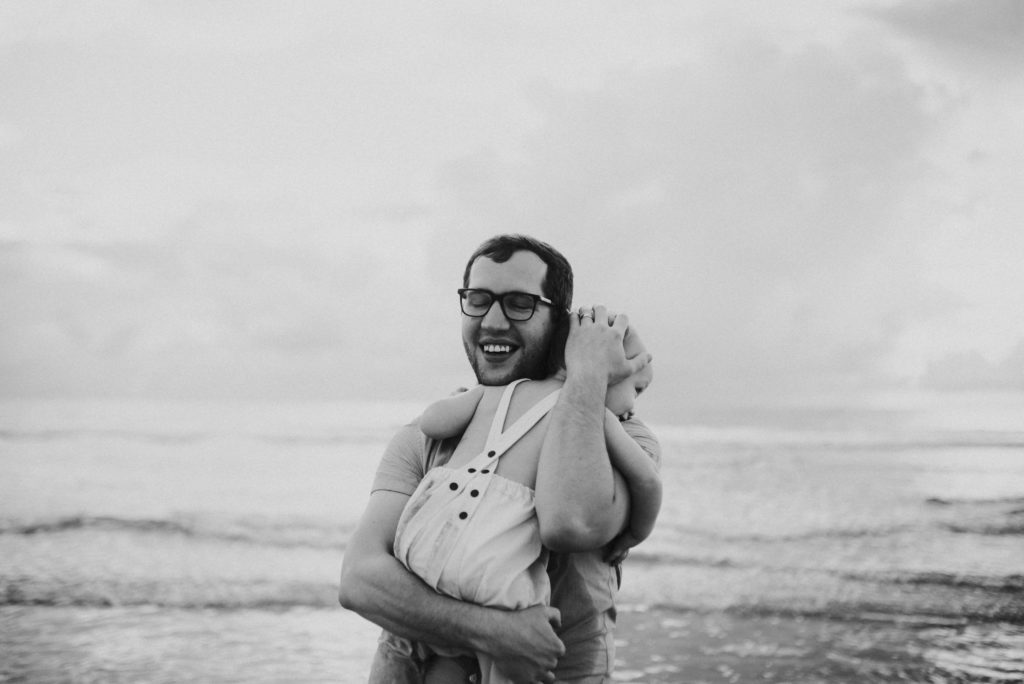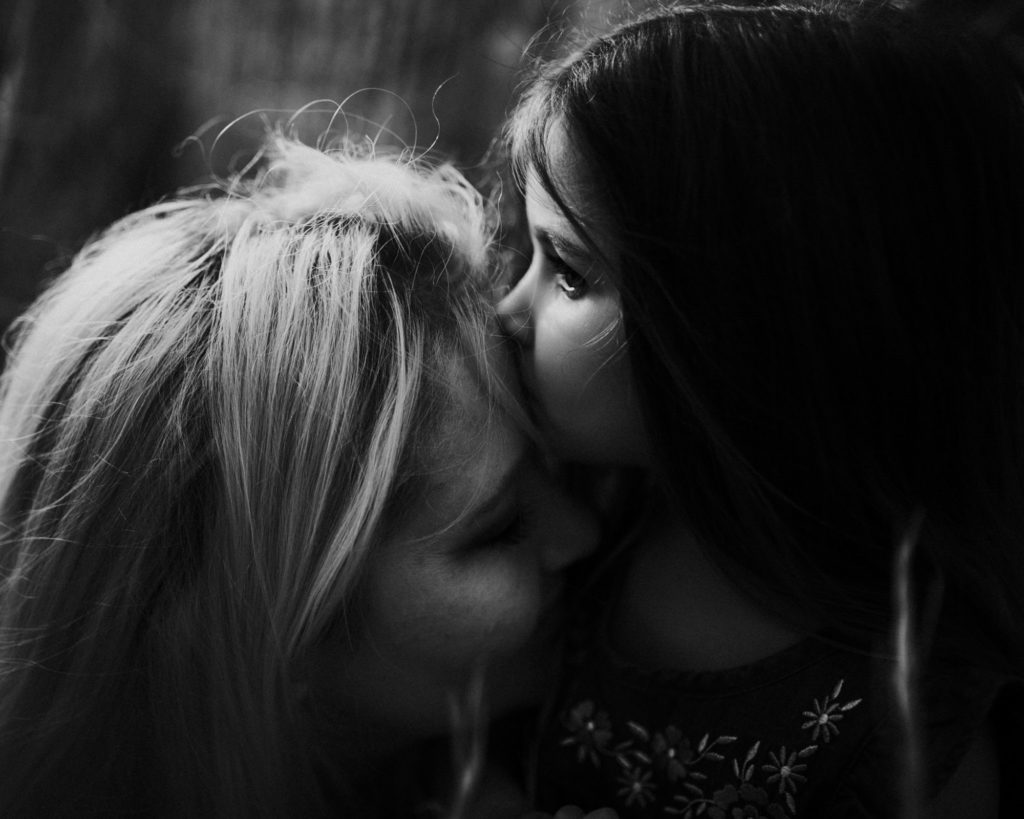The joy behind a genuine smile.
The tenderness of an embrace.
The feeling of the breeze on wind-swept hair.
When you first look at a photo, you may only see that one moment of time.
But the people in the photo can remember everything that was happening in that moment.
That emotion and authenticity can elevate a photo from something functional to something truly inspiring.
For Twyla Jones, that authenticity is her passion and the focus of her career. She’s a photographer in South Florida and mother to two little boys. I had the pleasure of chatting with Twyla recently about adding emotion and story to photography.
Drew: How did you end up focusing on this concept of emotional authenticity in your photography?
Twyla: This absolutely came from before I even had a camera. After Ari, my second son was born, I hired someone to come to our house and do newborn photos of him. I paid fifty dollars, so it’s also a good example of getting what you pay for.
So she came over and put him in a suitcase and on the floor and did all these weird things with him. They were photos that weren’t memories. They were just these very setup things.
So he would get upset because she was putting him in a suitcase, so I would pick him up to comfort him and I remember thinking that I really wish that she was taking photos of those moments because that’s what I wanted to remember. That time with my little baby and bonding and comforting.

It wasn’t until six or seven months before I ended up getting my own camera, but that thought was still heavy on my mind. I knew that I didn’t want to take pictures of people on hay bales posed together because that’s just not something that I would ever want. It’s not a photo that I would ever put on my wall because it’s not a memory.
Obviously, it’s a thing that happens but usually, those aren’t very fond memories. Your whole family getting posed and being told what to do, essentially being bossed around for a photo shoot.
So, I’d been taking and posting photos of my kids online, I didn’t mean to become a photographer or do that as a job but one day someone called me and asked me to do photos for her son’s birthday.
So I just planned this adventure through the woods for them and then that just started to resonate with them. There was no one else in my area doing photography like that at the time, so I just kept getting asked and that’s how my career in photography started.
Drew: That’s pretty fantastic. And how would you describe this concept of emotional storytelling as it relates to photography?
Twyla: It’s really about pacing yourself throughout a photo shoot to wait for those moments or seeking those moments out when you can find those authentic connections. For me those are always the best when it’s not something that I even directed, it’s just something that came out.

I’m especially looking for moments for families when the children get hurt or frustrated or something throughout the shoot. Because that’s when the parents are comforting them and then it’s authentic and the way that they react to that is authentic and that’s when you start to see the unique things about that relationship that you would never think to direct or pose while you’re shooting. That’s when these photos can become very familiar to the people you’re photographing. It’s like these little mannerisms that come out.
For instance, my son Ari, when he’s being really sleepy or feeling very cuddly, he rubs my ear and that’s not something that anybody would ever think to ask him to do but that’s a memory that I want to keep with me of him. So that would only happen in the instance that I am comforting him, so I’m always looking for opportunities like that.
That’s when you start to see the unique things about that relationship that you would never think to direct or pose while you’re shooting.
Everybody photographs differently and some people have a hard time relaxing in front of the camera and that’s when directing becomes much more important. What I do is I pay a lot of attention to the moments in my everyday life that just resonate strongly with me.
I think about what’s prompting those and then I carry that into my session to prompt people so that these images feel a lot more authentic but can also tell a story as well. That really helps draw the viewer in and maybe linger a little bit, linger on the image thinking about the story that it might tell.
For that I also use a lot of layering in my photography because I feel like it just has this really great storytelling aspect to it, having subjects in the foreground doing something and a subject that draws your focus or that I’m focusing on doing something else. I really like that.

Drew: It feels like there’s an element of self-care with this kind of photography. You’re talking about capturing moments where you’re passing your husband in the hallway or sharing a meal or anything like that. And really the people who benefit most from those photos are the people IN the photo. They see that photo and they’re reminded of that memory.
If a friend comes over and sees a photo of me and my wife playing while we’re trying to cook dinner or something, they don’t know that that was a real moment as much as they might think that it was a carefully planned spontaneity. But we know that we’re *actually* laughing and we’re *actually* having a great time.
Twyla: Yes, when I work with people I stress the idea of making time to really enjoy moments like that. I work with some people that feel like they are always too busy. A lot of people don’t take the time to do things like that and I think it’s incredibly important for your work, like more important than working is making time to have moments like that that you really enjoy.
I don’t use a list of poses or anything when I show up to a shoot, I don’t really prepare at all. I’m just open to the experience and then I’ve got all of these great memories in ways of interacting with the people that I love that just kind of come out and so I’m just looking for inspiration from the family and thinking about the things in the ways that I interact with my family when I need help directing them.
Drew: What would you say is your favorite photo that you’ve ever taken and been like, “YES, this is EXACTLY the moment I wanted”?
Twyla: A woman hired me for a photo shoot for her and her son the next day. So we went to the beach and it was overcast and super windy as well, this was right before the hurricane came last year, so everything felt like wild and electric too as it was coming in.

We were passing a rock and so I shoot at this beach with this really beautiful jetty. All of the sudden the sky opened up, just this hole in the clouds and the sun just started shining down, so I rushed to get her and her son over to the rock and I just had her rocking back and forth with him and so that entire series of photographs and then one in particular just like really nailed it. It feels so cinematic to me with all of the wind blowing, this perfect light, the way that she’s holding onto him but looking off into the distance, it’s like my ideal photograph. It’s got storm clouds but also perfect light shining through. That’s the one.
Drew: A lot of our customers are families and they take their own photos. What would you say to a family that, maybe they’re at that point where they want to do something beyond “everybody stand together, let me set the timer and run around then we’re all going to stand in front of the couch” Maybe they want to capture real emotions better or want to capture their life happening better, what would you say would be a first, simple step that they could take to lean in that direction?
Twyla: First of all, just think about the goal that you wish to achieve with your work and what emotions really resonate with you. Picking maybe three is a really good place to start and thinking of different ways that you can express that.
It can also help to cut it down to just two subjects. When I do family photography I spend a lot of my time photographing two people at a time. I find it’s difficult to maintain connections with more than two people.
We do take the family photos and the hugs and all of that with the entire family, but I really enjoy breaking it down and spending time on just the relationship between two people.

I have my emotion words; I like tenderness and joy and intimacy. So that’s what I have on my mind when I’m shooting. I want to create a joyful image for them because I know people want to have photos of themselves looking happy together.
Drew: That’s some great advice. So, how did you find out about Fracture?
Twyla: I hadn’t heard of Fracture before the Click Away conference. Then when I did I ordered two big prints of my kids. They’re amazing. I love them. Everybody always remarks. They stand out so much because they’re not just like usual prints and everybody wants to know what they are actually.
Drew: That’s always good to hear! Last question, if our readers see this and are really interested in following you more, what’s the best way for them to do that?
Twyla: I’m at @somethingrad, which is my client work on Instagram and then I have another that is just my personal Instagram of my kids, basically, and that one is twyla.jones. So that’s where the inspiration comes from and then you can see how I use it when I’m paid to do it, basically.

Thank so you much Twyla, for a wonderful conversation and tons of inspiration for approaching our photography with new eyes to capture more authenticity with every shot.


Comments